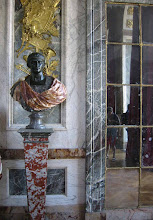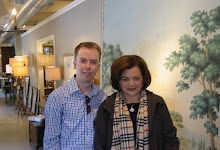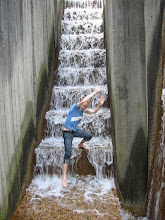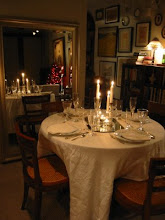Long time readers may remember a brief post I wrote in 2009 on Falkenlust Schloss which was based on a hunting lodge built at the palace grounds of Nymphenburg, Germany. That hunting lodge is Amalienburg which I'll discuss here.
Described as heaven on earth by my Australian penpal who provided me with these pictures, the rococo palace is Nymphenburg's answer to the Petit Trianon at Versailles (although built 20 years prior in 1739). This small building was built for the king's wife, Maria Amalia, as a hunting lodge or escape from the main palace or schloss.
The pink and white stucco exterior is perfectly symmetrical naturally.
The main salon is mirrored and silver-leafed to within an inch of its life while the rest of the paneling is painted a dreamy light blue.
The reflection of light from the french doors in the mirrors plus the light color helps blur the boundary of the space - imagine it on a sunny day!
Even if you don't like rococo I think you'll appreciate the workmanship and fine details.
The carved woodwork features women relaxing in nature with all manner of plants, hunting dogs, and birds.
The furniture is as magnificent as the wall detailing.
The bedroom is no simple place to rest ones' head. The portraits flanking the bed are of Maria Amalia and her husband Karl Albrecht who commissioned the structure.
Would you ever think yellow silk, and silver and yellow painted wood could be so pretty?
The adjacent 'hunting room' functions as a picture salon with paintings by Peter Jakob Horemans showing the couple at court hunts and functions; sort of an 18th century version of a den covered with family photographs!
Again the furniture perfectly matches the wall decorations.
The most charming rooms feature hand painted linen wall-coverings in chinoiserie style. Below the room is called the 'pheasant room' and you can see why with the animal so prominently featured.
A closeup of this wallcovering reveals how playful and modern the lines seem!
The 'dog and gun room' features a similar linen wallcovering in blue and white -even more blatantly chinoiserie in style.
Dogs slept beneath built-in gun storage in this charming space; quite the fancy kennel!
Even the kitchen was not spared the over-the-top decoration lavished on the rest of the palace. Delft tiles were used in profusion covering every surface including the stove.
These tiles feature birds and flowers, certainly an inspiration to Howard Slatkin in his own kitchen!
As I mentioned I realize rococo is not everyone's favorite but the attention to detail and workmanship are incredible and should be inspiring to all designers!
Subscribe to:
Post Comments (Atom)








































.jpg)





















.JPG)







































































7 comments:
Stefan I am at a loss for words ... So I'll just write these - dreamy, fairytale like, magical, elegant, mesmerizing beauty! Thanks for the beauty.
Vera
To think Stephane Boudin recreated a near facsimile for Chips Channon in the early 20thC says it all...a RARE JEWEL indeed.
The silver leaf hasn't any tarnishing, wonder if it's white gold...not a crevice or a corner tinged by oxidation...peculiar indeed.
Love this, and they say a Pavilion is too TOO! Hmmm...I can see myself awakening to the barking of a few Phalenes.
Absolutely delicious! The carving is beyond exquisite.
"Even if you don't like rococo" - did you mean me? ; ) When ANYthing is done this well, it's always a delight. : )
Just over the top with imagination!
I love it. Imagine the furnishings to be minimal and mod, it would be the perfect backdrop.
xo
pve
People who don't get Rococo probably suffer from a lack of imagination!
Dean
Hi, Stefan,
You are indeed lucky to have a penpal who shares such great, detailed photographs (though I'm sure I could say the same to him!).
When I see these mirrored Rococo rooms I always like to imagine how luxe they must have been in candlelight, with reflections not just in the mirrors, but on that gilt too!
Truly a Rococo gem!! I adore the dog sleeping niches. And the Chinoiserie wall coverings. Splendid!
Post a Comment